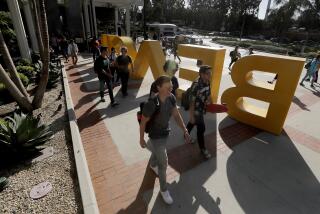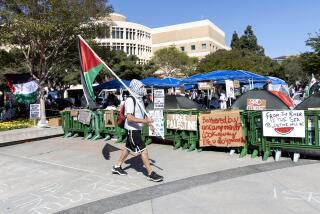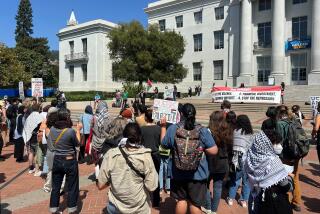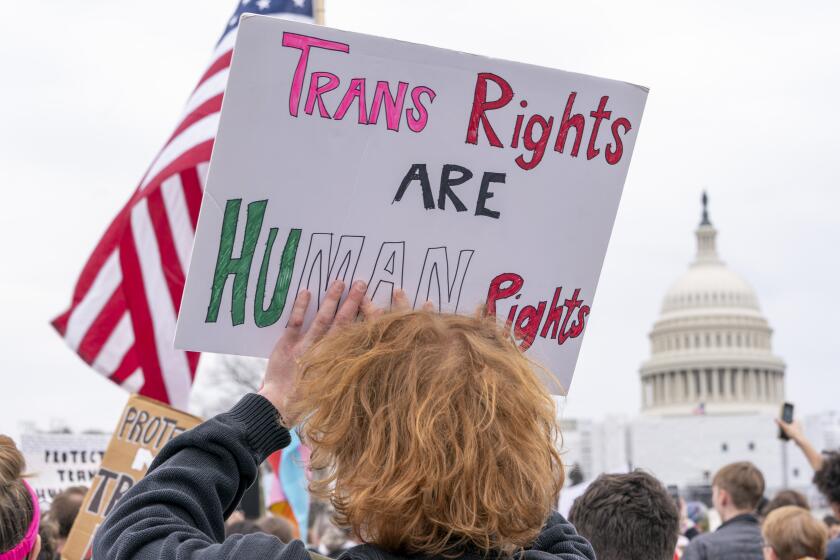Post-Quake Patience Wears Thin at CSUN
- Share via
NORTHRIDGE — When Cal State Northridge overcame the ravages of the January earthquake to begin its spring semester only two weeks late, the institution operated as the epitome of single-minded devotion to its chief goal: survival. Despite tremendous obstacles and primitive conditions, hardly a hint of complaint or dissent could be heard.
Today, however, the university is struggling into the final month of the school year on a campus that continues to operate mostly out of temporary trailers squeezed in between still-closed buildings. And the quake’s trauma has begun to take a more visible toll on CSUN’s nearly 28,000 students, faculty and staff.
As the quake’s initial sense of crisis has been supplanted by the day-to-day complications of life on a fractured campus, the once-united university has been splintered by frustrations and disputes. Even CSUN President Blenda J. Wilson, hailed as a hero for spearheading the reopening, has come under attack.
Hanging over the institution, as well, is a sense of anxiety about the future. Teachers and administrators fear enrollments could plummet next fall if students forsake a campus that may take three to five years to fully regain its pre-earthquake condition.
“I think it’s a very difficult time for everybody,” said Wilson. “I think we’ve just exhausted our capacity in some instances to do everything well.”
The campus, she said, must perform a juggling act--working to establish temporary facilities for the short term while repairing and rebuilding the permanent campus for the future.
Students and others add that their frustration grows as their desire for normalcy outstrips the pace of the recovery. Off campus, freeways are being repaired and businesses are reopening, but the scope of CSUN’s problems has it lagging.
“The first month was the easy part. Getting back up and going, even though it required seven-day weeks and a great deal of hard work, the task was fairly obvious,” said university spokesman Bruce Erickson. “But once you get into a long, drawn-out process of difficulty, frustration takes its toll.”
However, some on campus, particularly faculty members, also are blaming the flare-ups on the Wilson administration, which they say has been dictatorial and uncommunicative after the quake. The same headstrong approach Wilson used to help reopen the campus now has many chafing, critics say.
Among the sore spots:
* Faculty leaders have accused Wilson and her administrators of cutting them out of the decision-making process in the wake of the Jan. 17 earthquake, saying flagging faculty morale threatens to undermine the recovery process. Wilson has been conciliatory, but also complained that faculty committees have not been able to keep up with day-to-day decision-making demands.
* The student government last week passed a resolution with complaints of “widespread confusion among students as to the severity of damage to individual buildings” and the expected time frames for their reopening. The student leaders asked administrators to provide them monthly updates and to better publicize information in the campus newspaper.
* The task of trying to repair buildings has caused an angry rift between the academic and facility operations of the campus. Faculty members and others say repair crews rode roughshod over their office belongings, arriving without warning, damaging materials and then leaving rooms unlocked and vulnerable to theft.
* Wilson has ordered CSUN to plan for a 4% budget cut for the coming school year, although other Cal State campuses have been asked to trim only 2.6%. Faculty members say classes will be cut. Wilson aides say she wants to shift money among campus programs, and have a cushion for earthquake repairs and other looming expenses.
* Although Wilson promised time-and-a-half “emergency pay” to CSUN support workers called in to help prepare for the reopening of the campus, four labor groups have warned of a lawsuit because their estimated 750 employees have yet to get their bonuses. The pay has been stalled by a dispute between the groups and the university over other university-sought concessions.
* Students complain they sorely miss the university’s only library, both for its books and its study space, which is now in short supply. Some students say it is harder to learn in classes held in trailers or tentlike domes, and that professors are giving easier assignments.
* Relations have been strained with residents who live nearby. After the quake, the city of Los Angeles, at the university’s request, relaxed normal restrictions on parking in residential areas near CSUN, although that exemption ended last week. Residents also complain about gawkers who stream by to see the collapsed parking structure on Zelzah Avenue.
Then there are the minor, but annoying, irritants: Most keys to the new trailers have not worked. Wilson recalled how she kept sending electronic computer messages only to discover her colleagues couldn’t receive them. It’s also become apparent to anyone with a thirst that many of the campus drinking fountains are inside quake-damaged buildings.
The problems stem from the greatest loss due to natural disaster of any U.S. university, up to an estimated $350 million. Although the only collapse on campus was the 2,500-space parking structure, most of the university’s major buildings were initially closed due to damage. And operations shifted to more than 400 imported trailers.
Dorena Knepper, CSUN’s director of government relations, said 25% of the trailers should be removed by this fall and the rest by a year later. All but seven major buildings--the library, Fine Arts, Science 1 and 2, the computer center, Administration and Engineering--are due to reopen by this fall.
However, for that to happen, state voters in June must pass a ballot measure to provide the state’s required 10% matching share for federal earthquake repair funds. And, Provost Louanne Kennedy said, less-damaged buildings would have to be emptied for repairs this summer despite summer classes.
In the early days surrounding the Feb. 14 reopening, Wilson was hailed as a hero both on and off campus for leading the return at a time when some feared the campus might be closed for the semester. That reputation still stands off campus although it has dimmed at CSUN. “The heroine of the earthquake has clay feet,” quipped political science Chairman Eugene Price.
Faculty Senate President Louise Lewis, an art history professor who has been vocal in praising Wilson, still lauds her early performance but said faculty members must now take a greater role in making decisions. Tension among faculty members has risen to the point that they will vote soon on whether to remove administrators as members of the Faculty Senate.
“If you’re at war, no one objects to having a general. But after a while in the academy, we’re not accustomed to marching to a general’s orders,” said Jerry Luedders, chairman of the campus music department and of a faculty committee that recently issued a report complaining about what it called the “top down” mode of running the campus.
Another group of business faculty members wrote recently: “While we are painfully aware that the last thing that any of us wants to hear during this period of extreme stress is criticism, the purpose of this university is to educate students and, unfortunately, that goal seems to be getting lost in a sea of misdirected energies, miscommunications, angry words, bruised egos and finger-pointing.”
In an interview last week, Wilson said presidents of other universities that have suffered natural disasters have counseled her to prepare for such emotional swings. “This is not a peculiar reaction of our community,” she said, acknowledging the recent discord on campus.
In a recent letter to faculty members, she wrote, “I accept personal responsibility for the institution’s responsibility to provide a suitable working environment for our employees and engage faculty in the decisions that affect them. That I have not been successful in doing so recently is evident in the comments and concerns that faculty and staff have expressed.”
But Wilson, in the interview, rejected criticism that she has failed to consult with the faculty, saying she has done so regularly with deans and department leaders. And Wilson said she couldn’t say whether CSUN’s internal communications after the quake have been inadequate as many claim. She said the campus has done more in that area than ever before.
As for the students, Fabio Escobar, newly elected student body president, said many are spending less time on campus, because of the closed library and because many of their former eating and meeting locations also remain closed. Students seem to be studying less, and many professors have canceled research-intensive assignments such as term papers, he and other students said.
“It’s been a long semester. People learn to adjust rather quickly. But eventually it wears thin, and it’s worn thin,” Escobar said. “In the beginning, people were more willing to forgive transgressions because it was an emergency situation. Now they’re not so willing.”
With the parking structure gone and some on-campus lots now occupied by villages of trailer classrooms, using remote, improvised parking lots has been a constant frustration. And just finding faculty members for help has become a struggle, Escobar said, because most still don’t have their own offices or telephones in communal faculty office trailers.
“The first couple days were exciting. CNN was here, students were having to use maps to find their classes. But after three or four days, it definitely wore off,” concurred Steve Kozak, a senior and the managing editor of the Daily Sundial campus newspaper. Kozak and Editor Paul Bond said they have struggled all year to get information from university officials.
Bond summed up the spring, saying, “It’s exciting, but don’t expect to get a good education here until next semester.” And Kozak said the campus “is just filled with students packed into trailers who have no sense of what’s happening with their university.” Because of the semester’s turmoil, both said they have had to delay their planned graduations.
CSUN’s graduating class of bachelor’s and master’s degree students in June may be one of the largest ever--more than 5,211 students have filed for graduation and typically 70% of those filing actually complete their requirements by the semester’s end. But that is little cause for celebration.
The enrollment from last spring already fell 6.6% this semester to 24,813, the lowest spring enrollment since 1974, records show. For the fall, some campus officials fear a major enrollment drop because of the combination of the large graduating class and the assumption that many CSUN students may use their summer break to find campuses elsewhere.
Amid all the problems on campus, though, one student senator insisted he will be back in the fall. “It’s not so bad. I’m graduating in June and I’m staying on at this university for my master’s,” said Tadzio Garcia, a senior music major. “We just have to get used to not having everything we had before.”
Quake Damage Estimates
Latest estimates of damage to Cal State Northridge facilities from the Jan. 17 earthquake. Parking Structure C: $31,146,000 University Tower Apartments: $28,747,000 Oviatt Library: $20,991,000 University Park Apartments: $16,461,000 Fine Arts: $12,961,000 South Library: $7,811,000 Sierra Tower: $7,000,000 Administration: $6,013,000 Music: $5,500,000 Engineering: $4,000,000 Speech-Drama: $3,366,000 Science 1: $3,000,000 Science 2: $3,000,000 Richfield Hall: $2,500,000 Sierra South: $2,500,000 Landscaping: $2,500,000 Science 3/Planetarium: $2,000,000 Engineering Addition: $1,500,000 SABE&E; Complex: $1,500,000 Science 4: $1,450,000 Misc.: $5,514,000 TOTAL: $169,460,000 Source: Cal State Northridge
More to Read
Sign up for Essential California
The most important California stories and recommendations in your inbox every morning.
You may occasionally receive promotional content from the Los Angeles Times.













